Table of contents
- Comparison test: Big Bikes from Honda and Suzuki Test: Honda CBF 1000 F, CB 1300 S and Suzuki Bandit 1250 S
- Comparative test of big bikes: part 2
- Technical data Suzuki Bandit 1250 S
- Technical data Honda CBF 1000 F
- Technical data Honda CB 1300 S
- MOTORCYCLE measurements
- Intermediate sprint
- MOTORCYCLE test result
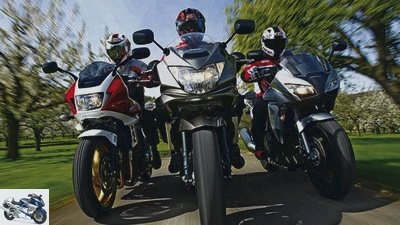
Gargolov
motorcycles
Comparison test: big bikes
Comparison test: Big Bikes from Honda and Suzuki
Test: Honda CBF 1000 F, CB 1300 S and Suzuki Bandit 1250 S
The top position of the Bandit in the Big Bikes is unchallenged … Still. Because in addition to the well-known and high-quality, but more expensive CB 1300 S, Honda is now pushing the CBF 1000 F from below to dispute the territory of the Suzuki.
Andreas Bildl
05/14/2010
The rising sun blinks teasingly over the edge of the forest, carefully pushing copper-red rays into the day. The benches are still lightly covered with the dew of the night. The air is still cool, but tastes fresh. It’s going to be a wonderful day. Finally. The winter was long and dreary enough. A day is made to be enjoyed at leisure, without stress. Upright, with a lot of displacement and serenity.
That has always been the profession of the Suzuki Bandit 1250 S. In the previous year alone, almost 2,000 buyers in Germany saw this as well and lifted the big Bandit to fourth place in the registration statistics. So far, Honda has held against it with the all-round talent CBF 1000. Now the new CBF 1000 F is supposed to put the bandits on their feet even more. And for those for whom the deleted liter displacement is not enough, Honda has the very pretty CB 1300 S ready, last year Alpine Masters winner and upgraded this year by the composite ABS.
Buy complete article
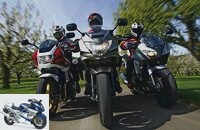
Comparison test: Big Bikes from Honda and Suzuki
Test: Honda CBF 1000 F, CB 1300 S and Suzuki Bandit 1250 S
11 pages) as PDF
€ 2.00
Buy now
At least in terms of performance, the three are close together. Is the CB 1300 S the right answer to Suzuki’s long-running Bandit, or is the smaller, but more modern one CBF 1000 F the pike in the big bike pond?
From the outside, the CB 1300 S definitely sets the tone. It stands there as massive as a mountain range. The impression is also confirmed when you take a seat. What a dream. Wide handlebars, huge, long tank, a bench like a sofa, on which you can loll comfortably. Including a towering monument by Motor. The lavish half-shell cladding not only houses two storage compartments, one of which is lockable, but also two conventional round instruments in the old fashioned way. Analog, clearly and neatly drawn, beautiful. It demonstrates visual closeness to the ancestors of the eighties without trying to ingratiate itself with clumsy retro demeanor. In terms of price, at 12,660 euros, it clearly depends on both CBF (11090 euros) and Bandit (9535 euros). But their processing is also in a class of its own.
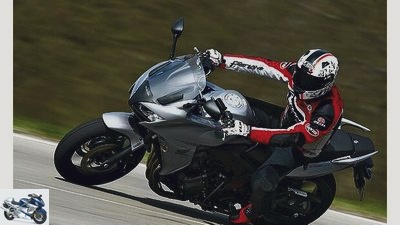
Gargolov
A real good-mood bike is hidden behind the simple gray garment.
Against this colossus, the CBF 1000 F works almost like half a serving. Much more compact, yet with sufficient freedom of movement and a relaxed sitting posture with a nuance of sport, it fits the driver more like a well-fitting suit. The handlebars are not too narrow, the central tachometer and the bar above it with indicator lights are clearly visible. The fact that the seat height can be varied in two positions and the windshield in four positions underscores her all-rounder ambitions. Outwardly, she looks dynamic with her cat’s eyes.
Somewhere in between, the almost plainly dressed bandit lines up. Lots of space, relaxed knee angle, only the handlebar ends, which are strongly cranked towards the driver, disturb the harmony. All three immediately answer the starter’s call with a satisfied grumble. For the first few meters, the Suzuki clears its throat a little, while the Hondas purr gently at a slightly increased speed from the spot, but after a few seconds that is done and the relaxed country road swing can begin. The streets wind their way through the landscape, strictly following the topography. The panels all protect the upper body, but allow the wind and the fresh morning air to flow around the helmet with relish. And the gently humming four-cylinder power plants exude calm and serenity. Switching speed 3000. Purr at low speed, let the torque work and enjoy. Especially on the CB 1300 S.
The way this powerhouse pushes the 266-kilo trump forward from the very lowest locations is a pleasure. Even in fifth and thus the last gear of the smooth-running gearbox. Gentle and unyielding like a Chevy V8, it never leaves the slightest doubt that there is never-ending thrust in the engine room. In addition, the big block mumbles to itself with a comfortably velvety bass. The Suzuki drive is not inferior to it when it comes to powerful power from the deepest revs. On the contrary.
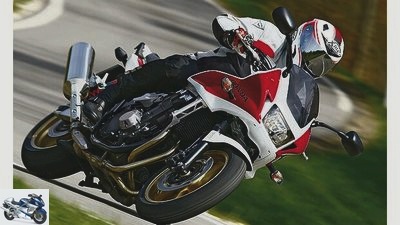
Gargolov
Once on the move, it seems to shake off a hundred pounds of weight.
Load change reactions are present as with the CB 1300 S, but never disruptive. In addition, it reacts more spontaneously to movements of the throttle hand than the CB. Even just above idle, the 1250 pulls through unimpressed. It might not sound as sonorous as the Honda four-wheeler, rather a bit tinny, but at least in the lower speed range, the rubber mounts of the engine, handlebars and pegs absorb the existing vibrations very effectively. Only higher speeds cause a noticeable tingling sensation to wander through the notches and handlebar ends.
The CBF drive does not punch its way up from the speed ground floor quite so energetically and confidently. Even if he is the only one receiving support from a valve in the exhaust. Up to 3000 rpm, his forward thrust is manageable compared to the other two. The power of displacement cannot be replaced by anything. This is particularly evident when pulling qualities are required almost fully loaded. Then the CBF is left with nothing but neglect.
By the way, unlike the two big blocks, their engine was not specially designed for its intended use, but actually comes from an athlete. More precisely: from the Fireblade from 2007, with a modified CB 1000 R cylinder head trimmed for more torque. However, he cannot completely deny his athletic genes. Over 3000 rpm comes to life in the booth and it turns lightly upwards. Above all, however, the engine runs as smooth as silk, picks up the gas at the apex of the bend and accelerates smoothly even just above idle.
Comparative test of big bikes: part 2
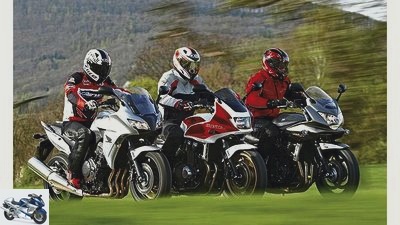
Gargolov
Whether it’s sporty driving or strolling down the country roads, both are no problem with these bikes.
If you like to spend a day in the saddle and not only want to stroll and tour, but also want to race around corners in a sporty way, you are in good hands with CBF. not just because of the engine. The aluminum chassis cuts a fine figure here too. Sure, on the one hand, the CBF, at 244 kilograms, carries significantly less gold than the Bandit (252 kg) or even the CB 1300 S (266 kg). On the other hand, she is content with a moderate 160 tire on the five-inch narrow rear rim, while the other two want to be maneuvered around corners on a fat 180.
And so the CBF rushes with impressive suppleness and a matter of course, even through winding curves. The CB 1300 S and Bandit are a long way off this dynamic. Nevertheless, you don’t need to have jitters in front of winding side streets on the two. On the contrary. The CB 1300 S pilot in particular rubs his eyes in amazement at how easily his truck can be turned through the curves. Once on the move, he develops astonishing agility, similar to a sumo wrestler. You certainly notice the high weight in alternating curves, but the CB 1300 S follows the given line just as willingly and naturally. A day of turning corners by no means degenerates into sweaty work.
The Suzuki Bandit follows in a similarly agile manner. However, it does not hit the targeted line with the same stoic composure and wants to be guided a little more concentrated. Meanwhile, the CBF is over the mountains. Not only is it the most agile, it also sails more neutrally around long, tight curves than the others. Bumps? Grip on the brake? Both of these are hardly upset for CBF. In addition, their spring elements filter bumps and bumps from the road surface extremely carefully without slipping into the spongy.
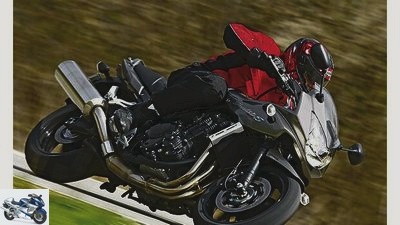
Gargolov
The bandit is a fixture on big bikes.
The CB 1300 S also pulls its course full and stable. In return, it got significantly tighter springs and more cushioning for 2010. It masters long waves confidently, but its spring elements do not absorb fine, short impacts as smoothly as with its smaller sister, which is also ahead of the curve when it comes to erecting it. The Bandit dedicates itself to small bumps a little less intensively, rolling over them a little woodenly. In addition, your bench upholstery does not have the sofa qualities of the CB 1300 S chair. Nevertheless, when it comes to the big tour for two, she is in the front row.
On the one hand, it offers the passenger the best amount of space, where of all things the CB 1300 S fails with quite high notches and unfavorably placed handles. On the other hand, no other offers so much lean angle freedom and payload. 220 kilograms are compared to a measly 193 for the CB and a total of 196 for the CBF.
However, the Suzuki brakes appear a bit dull and require a firm grip, which is associated with compromises in terms of controllability. The CBF stoppers and even more the brakes of the CB 1300 S close more spontaneously and energetically. However, if it goes all the way, the picture changes. The Suzuki ABS regulates inconspicuously but efficiently, while the Bandit achieves the highest deceleration without flinching. If this happens on bumpy asphalt, the difference becomes even clearer. The Bandit stays firmly on track and decelerates a bit better than the good CBF. The CB 1300 S, however, draws long black lines, dances nervously on the front wheel and takes the longest to come to a standstill. The aged Dunlop D 220 does not seem to be very helpful.
Sunshine and unity prevail among the three later at the pump. After around four hundred kilometers, you get down relaxed after about four hundred kilometers, still fresh enough to do more, and are pleased to see that around five liters per hundred kilometers, with a slight advantage for the CBF, is more than okay in terms of stature and cubic capacity.
In the end, the morning didn’t promise too much. It was the start of a wonderful day through and through.
Technical data Suzuki Bandit 1250 S
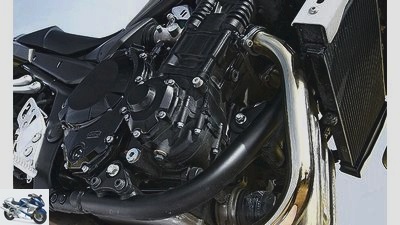
Gargolov
Fully encased in rubber, visually imposing, indicated cooling fins refer to the air-cooled roots.
Technical data Suzuki Bandit 1250 S
ENGINE:
Water-cooled four-cylinder four-stroke in-line engine, two overhead, chain-driven camshafts, four valves per cylinder, bucket tappets, wet sump lubrication, injection, Ø 36 mm, regulated catalytic converter with secondary air system, 400 W alternator, 12 V / 10 Ah battery, hydraulically operated multi-disc oil bath clutch, Six-speed gearbox, O-ring chain, secondary ratio 43:18.
Bore x stroke 79.0 x 64.0 mm
Displacement 1255 cm3
Compression ratio 10.5: 1
rated capacity 72.0 kW (98 PS) at 7500 rpm
Max. Torque 108 Nm at 3700 rpm
LANDING GEAR:
Double loop frame made of steel, telescopic fork, Ø 43 mm, adjustable spring base, two-arm swing arm made of aluminum, central spring strut with lever system, adjustable spring base and rebound damping, double disc brake at the front, Ø 310 mm, four-piston fixed calipers, disc brake at the rear, Ø 240 mm, single-piston floating caliper, ABS.
Cast aluminum wheels 3.50 x 17; 5.50 x 17
Tires 120/70 ZR 17; 180/55 ZR 17
Front tires in the test Dunlop D 218 “T”, rear “N”
Mass and weight:
Wheelbase 1485 mm, steering head angle 64.7 degrees, caster 104 mm, spring travel f / h 130/136 mm, seat height * 790-810 mm, weight with a full tank * 255 kg, payload * 220 kg, tank capacity 19.0 liters.
guarantee two years
Service intervals 6000 km
To dye Black, gray, brown
price 9,390 euros
extra costs around 145 euros
* MOTORCYCLE measurements
Technical data Honda CBF 1000 F
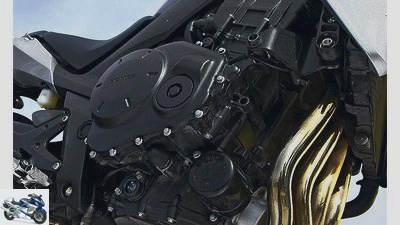
Gargolov
Modern engine architecture. Low, compact, gear shafts moved close together.
Technical data Honda CBF 1000 F
ENGINE:
Water-cooled four-cylinder four-stroke in-line engine, two overhead, chain-driven camshafts, four valves per cylinder, bucket tappets, wet sump lubrication, injection, Ø 36 mm, regulated catalytic converter, 350 W alternator, 12 V / 9 Ah battery, hydraulically operated multi-disc oil bath clutch, six-speed gearbox, O-ring chain, secondary ratio 41:16.
Bore x stroke 75.0 x 56.5 mm
Displacement 998 cm3
Compression ratio 11.2: 1
rated capacity 79.0 kW (107 hp) at 9000 rpm
Max. Torque 96 Nm at 6500 rpm
LANDING GEAR:
Backbone frame made of aluminum, load-bearing motor, telescopic fork, Ø 41 mm, adjustable spring base, two-arm swing arm made of steel, central spring strut, directly hinged, adjustable spring base and rebound damping, double disc brake at the front, Ø 296 mm, three-piston floating caliper, disc brake at the rear, Ø 240 mm, single-piston Floating caliper, partially integral brake system with ABS.
Cast aluminum wheels 3.50 x 17; 5.00 x 17
Tires 120/70 ZR 17; 160/60 ZR 17
Tires in the test Bridgestone BT 57 front “U”, rear “E.”
Mass and weight:
Wheelbase 1495 mm, steering head angle 64.0 degrees, caster 110 mm, spring travel f / r 120/120 mm, seat height * 780-810 mm, weight with a full tank * 244 kg, payload * 196 kg, tank capacity 20.0 liters.
guarantee two years
Service intervals 6000 km
To dye Black, silver, white
price 10890 euros
extra costs around 200 euros
* MOTORCYCLE measurements
Technical data Honda CB 1300 S
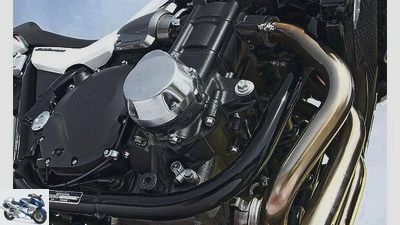
Gargolov
A towering sculpture with chrome-plated camshaft covers and a huge clutch bell.
Technical data Honda CB 1300 S
ENGINE:
Water-cooled four-cylinder four-stroke in-line engine, two overhead, chain-driven camshafts, four valves per cylinder, bucket tappets, wet sump lubrication, injection, Ø 36 mm, regulated catalytic converter with secondary air system, 420 W alternator, 12 V / 11 Ah battery, hydraulically operated multi-disc oil bath clutch , Five-speed gearbox, O-ring chain, secondary ratio 39:18.
Bore x stroke 78.0 x 67.2 mm
Displacement 1284 cm3
Compression ratio 9.6: 1
rated capacity 84.0 kW (114 hp) at 7750 rpm
Max. Torque 116 Nm at 6000 rpm
LANDING GEAR:
Double loop frame made of steel, telescopic fork, Ø 43 mm, adjustable spring base, two-arm swing arm made of aluminum, two spring struts, adjustable spring base and rebound damping, double disc brake at the front, Ø 310 mm, three-piston fixed calipers, disc brake at the rear, Ø 256 mm, single-piston floating caliper, composite brake, partially integral -Brake system ABS.
Cast aluminum wheels 3.50 x 17; 5.50 x 17
Tires 120/70 ZR 17; 180/55 ZR 17
Dunlop D 220 tires tested “K”
Mass and weight:
Wheelbase 1515 mm, steering head angle 65.0 degrees, caster 99 mm, spring travel f / r 120/116 mm, seat height * 805 mm, weight with a full tank * 266 kg, payload * 193 kg, tank capacity / reserve 21.0 / 4.5 liters.
guarantee two years
Service intervals 6000 km
To dye Red / white, black
price 12490 euros
extra costs around 170 euros
* MOTORCYCLE measurements
MOTORCYCLE measurements
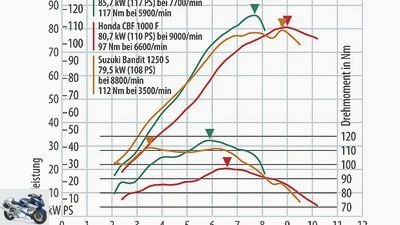
Drawing: archive
Power on the crankshaft, measurements on Dynojet roller test bench 250, corrected according to 95/1 / EC, maximum possible deviation +/- 5%
The Bandit draws an almost fantastic torque curve, which practically always provides at least 100 Newton meters from the start. The CB 1300 S only outperforms it from 5000 rpm. The dent at 8500 rpm does not really matter to the Bandit in everyday life. The power output of the CBF 1000 F runs nicely evenly. It reaches its zenith early. But due to the smaller displacement, she keeps a respectful distance from the two big pots.
MEASUREMENTS
Top speed (manufacturer information)
| motorcycle | Km / h |
| CBF 1000 F |
230 | CB 1300 S |
230 |
| Bandit 1250 S |
230 |
acceleration
| motorcycle | 0-100 km / h | 0-140 km / h | 0-200 km / h |
| CBF 1000 F | 3.5 | 5.8 | 14.0 | CB 1300 S | 3.3 | 5.8 | 13.0 |
| Bandit 1250 S | 3.5 | 6.1 | 14.2 |
Draft
| motorcycle | 60-100 km / h | 100-140 km / h | 140-180 km / h |
| CBF 1000 F | 4.2 | 4.7 | 5.8 | CB 1300 S | 3.8 | 4.2 | 4.7 |
| Bandit 1250 S | 4.0 | 4.3 | 5.4 |
Fuel consumption (country road)
motorcycle
Theoretical range (country road)
| motorcycle | Km |
| CBF 1000 F | 455 | CB 1300 S | 420 |
| Bandit 1250 S |
396
Intermediate sprint
Does the power of the displacement rule even when fully loaded during the intermediate sprint, or do power and short gear ratio count more?
Big tour with a pillion passenger and some luggage. Exit of town, slow car ahead. Now it has to be done quickly. Who pulls through in which gear and how fast? Measurements were taken with two people and some luggage, a total of 190 kilograms – which is already reaching the limit of their capacities. Packed like this, the displacement advantage counts more than pure performance. And: Despite the longest final translation, the Bandit accelerates away with the load of the competition.
Pulling speed 50-140 km / h
motorcycle
MOTORCYCLE test result
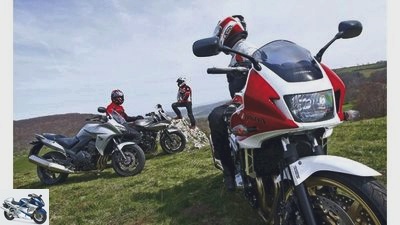
Gargolov
Three bikes with which the excursion into the countryside becomes a pleasure.
1st place: Honda CBF 1000 F
If you like things to be dynamic on tour, you’ve come to the right place. Great handling, comfortable chassis and relaxed seating position comfort the lack of power of the displacement.
2nd place: Honda CB 1300 S
The bike for connoisseurs. The space is plentiful, both heart and eye get their money’s worth. Impressive pressure and handling. The ABS brakes on bumpy roads, however, do not.
3rd place: Suzuki Bandit 1250 S
The bike for pragmatists. The engine is still a stunner, it is the first choice for tours for two. And it is the cheapest in this field anyway.
MOTORCYCLE rating
Category engine:
Measured by its small displacement in this field, the CBF 1000 F does quite well in the pull-through test. Your engine shines with the best manners in terms of vibrations and load changes. Coupling the bandit requires a strong hand. In addition, it has a very long translation, which at least reduces fuel consumption and engine speed.
Winner engine: Honda CB 1300 S
Category chassis:
A clear matter for the CBF 1000 F. Although the CB 1300 S and Bandit seem quite agile for their weight. In terms of handiness, however, the CBF plays in a different league. Its suspension elements are best coordinated, which means that they are ahead of the curve even in curves. Adjustment options on the chassis are in short supply for all three.
Chassis winner: Honda CBF 1000 F
Category everyday life:
If you want to stay like a king, you should try the seating furniture of the CB 1300 S. The strongly cranked handlebars annoy the Bandit. For this, a passenger is best taken care of with her. And she shoulders the most luggage by far. The CB 1300 S has the largest tank with 21 liters, but the economical CBF still converts its 20 liter tank capacity into the largest range.
Winner everyday life: Honda CBF 1000 F
Category Security:
The bandit’s brakes require a lot of manual force, but together with the finely tuned ABS it still ensures strong deceleration. Below the control range, the CB 1300 S brake shines with a spontaneous, easily controllable bite.
Security winner: CBF 1000 F / Bandit
Category costs:
A tight box, in which the smallest wins, mainly thanks to the lowest consumption.
Winner cost: Honda CBF 1000 F
| |
CBF 1000 F |
CB 1300 S |
Bandit 1250 S |
|
| Overall rating | Max. 1000 | 674 | 650 | 646 | placement | 1. | 2. | 3. |
| Price-performance note | Top grade 1.0 | 1.5 | 2.3 | 1.5 |
Price-performance winner: CBF / Bandit
The bandit still offers a hell of a bike for the money, creating a stalemate.
Related articles
-
Comparison test Honda CBF 1000 F and Suzuki Bandit 1250 S
Bilski 32 pictures Bilski 1/32 The CBF 1000 F looks more elegant, dignified, sleeker. The 1250 Bandit comes across as beefier, more powerful with a more…
-
Comparison test: Honda CBF 1000 Silverline, Suzuki Bandit 1250 S, Yamaha FZ1 Fazer
Jahn 22nd pictures Honda 1/22 Honda CBF 1000 Honda 2/22 Honda CBF 1000 Zdrahal 3/22 Presentation at the fair in Paris. Honda 4/22 Honda CBF 1000 Honda…
-
Comparison test Honda CBF 1000 against Suzuki Bandit 1250 S
Rossen Gargolov motorcycles Comparison test Honda CBF 1000 against Suzuki Bandit 1250 S Comparison test Honda CBF 1000 against Suzuki Bandit 1250 S We…
-
Comparison test: Japanese naked bikes
Jahn motorcycles Comparison test: Japanese naked bikes Comparison test: Japanese naked bikes Go big Content of …or go home! Big bore instead of boring,…
-
Artist 48 pictures Artist 1/48 Four inexpensive motorcycles have appeared in the south of France … Artist 2/48 Artist 3/48 The winner of the 1000-point…
-
Comparison test between Suzuki DL 1000 V-Strom and Yamaha TDM 900
Artist motorcycles Comparison test between Suzuki DL 1000 V-Strom and Yamaha TDM 900 Comparison test between Suzuki DL 1000 V-Strom and Yamaha TDM 900…
-
Comparison test: Honda CBF 600 S and Kawasaki ER-6f
Gargolov motorcycles Comparison test: Honda CBF 600 S and Kawasaki ER-6f Comparison test Honda CBF 600 S and Kawasaki ER-6f They don’t shine in the…
-
Comparison test: Honda Hornet, Kawasaki Z 750, Suzuki GSR 600
Jahn motorcycles Comparison test: Honda Hornet, Kawasaki Z 750, Suzuki GSR 600 Comparison test: Honda Hornet, Kawasaki Z 750, Suzuki GSR 600 ABS shooters…
-
Comparison test Honda CBF 125 against Yamaha YBR 125
fact motorcycles Comparison test Honda CBF 125 against Yamaha YBR 125 Comparison test Honda CBF 125 against Yamaha YBR 125 Inexpensive 125cc singles No…
-
fact motorcycles Middle class comparison test Middle class comparison test Just turn blue The sun is shining, the early autumn beckons: away with pencil…